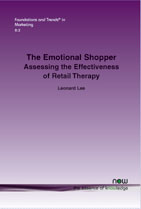The Emotional Shopper: Assessing the Effectiveness of Retail Therapy
By Leonard Lee, National University of Singapore, NUS Business School, Singapore, leonard.lee@nus.edu.sg
Abstract
Shopping is an integral part of our everyday lives. Common wisdom suggests that many consumers engage in shopping and buying as a means to repair their negative feelings — a notion commonly referred to as retail therapy. However, does retail therapy really work? The present monograph seeks to address this question by proposing a tripartite approach, reviewing and organizing relevant research in marketing and consumer psychology based on this tripartite framework: (1) motivational (the goals and motives that consumers have for shopping); (2) behavioral (the activities in which consumers engage during the shopping process); and (3) emotional (the feelings that consumers experience while shopping). Although accumulating evidence suggests that retail therapy does work to a certain extent, simultaneously considering the three perspectives in future empirical investigation helps to further improve our understanding of the antecedents, underlying mechanisms, and consequences of retail therapy. Accordingly, a number of questions and directions for future research on the topic of retail therapy are discussed, drawing upon the proposed tripartite framework.
The Emotional Shopper: Assessing the Effectiveness of Retail Therapy
The Emotional Shopper: Assessing the Effectiveness of Retail Therapy examines the question to what extent retail therapy really works. The monograph reviews the extant literature on shopping behavior and emotions, and adopts a tripartite approach to provide a more systematic and holistic treatment of this subject. The author assesses whether retail therapy works according to three perspectives: (1) motivational, (2) behavioral, and (3) emotional. Shopping is seen as a hedonic experience that triggers a variety of emotions. The incidence (or lack) of these specific emotions when consumers shop is examined.
The Emotional Shopper: Assessing the Effectiveness of Retail Therapy first reviews some conceptual foundations of the notion of retail therapy, including its definition and scope as well as the scales that researchers have developed to measure it. Next, it delves into the three aforementioned perspectives, assessing the effectiveness of retail therapy from each perspective by discussing and analyzing relevant work that has adopted the particular perspective. Finally, the author concludes with a general discussion of the main findings as well as some questions and directions for future research.
